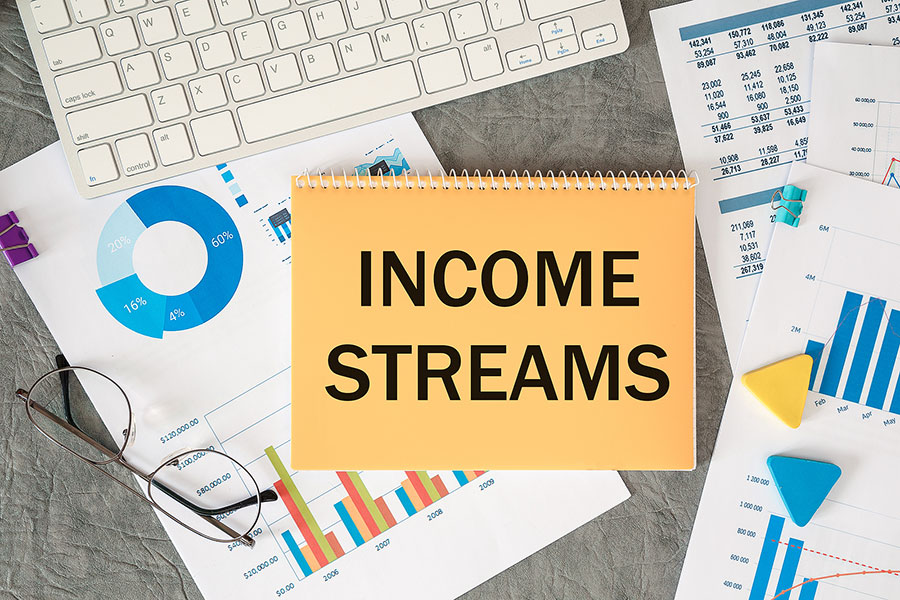
In order to become wealthy, you will need to have more than one stream of income. If you have a job, that is one stream of income. If your spouse has a job, that would be a 2nd source of income. However, the entire point of this blog is to get you out of work and living a financially free life where other things are creating income for you. As those other income streams grow and cover the cost of your living expenses, you can rely on your personal income streams less.
WHAT ARE EXAMPLES OF OTHER STREAMS OF INCOME
By this time, you should have determined what your goal is for passive income. How much money do you need on a monthly basis to be able to cover all of your necessities? For me, I would like to have $20,000 per month in passive income. If I didn’t have kids in the house, I figure I could live on passive income of $20,000.
We have discussed how investing money into different things can generate interest and that interest can be reinvested to create more money for you, but all of those examples really imply that you are working and money is being pulled from your paycheck each month and reinvested and you really aren’t going to see that money until you retire. So how can you get more money today?? How can you supplement the money you earn at your job with extra cash now? Here are some ways to create more streams of income:
- Real Estate investment
- Side gigs
- Start a company
REAL ESTATE INVESTMENT
Real estate investment provides the ultimate in passive income. Everyone needs a place to live and everyone who doesn’t own a house, pays rent somewhere. There are different kinds of real estate investment, but we can start with residential real estate.
Real Estate Investment for The Youngsters
If you are in your 20s and you can put together enough money for a rental property, you can rent rooms to roommates or friends to help carry the debt burden. If you play your cards right, your expenses after renting out rooms could be far less than what you were paying for rent before you bought the property.
Here’s an example. Let’s say you live in Pittsburgh, an up and coming investment real estate area. You were living in an apartment and paying $800/month in rent. I was able to find a number of homes that cost about $250,000 and are 3 bed, 3 bath homes. If you are able to put down $25,000 for the home, you would have a loan balance of $225,000 and at 3.5% interest, this would cost $1,010 per month in mortgage payments. There are going to be some other fees including:
- Mortgage: $1,010
- Insurance: $150/month
- Property Taxes: $210 (1% of the purchase price divided by 12 months)
- PMI: $187/month (based on 1% of the loan amount per year)
- HOA: $100/month
- TOTAL: $1657/month
Since you only put down 10% of the purchase price, you are stuck with the monthly PMI (Private Mortgage Insurance). Private Mortgage Insurance is a separate fee the bank wants you to pay because you don’t have enough skin in the game when you only own 10% of the property. Almost every loan requires PMI unless you put down 20% or more. The average cost of private mortgage insurance, or PMI, for a conventional home loan ranges from 0.58% to 1.86% of the original loan amount per year, according to Genworth Mortgage Insurance. In this case, we estimated your PMI at 1% which is a pretty big number each month.
These are just random estimates and homes there might not have HOA. After you review the property and the fees above, you will have a solid idea as to your real costs. The next step is to go to Zillow or other RENTAL web sites and determine what the fair market rent is for houses like this. If the rents are around $1900/month, you’re looking good. $1900 – $1660 in costs is $240/month in positive cashflow. Now, let’s assume you were paying rent of $800/month and now you move into the property and charge $600 to your friends for rent for the other two rooms. 1) BONUS – you get to live with some friends, and 2) they would pay $1200 of your mortgage and you would be paying $457/month to own the home. You actually saved money by purchasing the home.
Once you move into the property, you need to start watching the housing market. If the housing market increases, you can try to refinance and get a lower mortgage rate and, if the property has increased 10% in value, you would then own over 20%, you would get out of the PMI payment which would provide even more profit. If you have a good payment history and interest rates are lower, you should be able to get a deal. In this scenario, purchasing a house that needs some work done is also a great idea. If you are handy at all, you can move into a fixer and add some paint and redo the floors and get the value up so you can get rid of the PMI. Maybe one of your friends can help out with the renovations.
While you are living at your new house, you can put away any extra savings you gained by having roommates and start looking at buying another property. Let’s assume you were able to refinance the first house and lower your payments AND remove the PMI. How would that look now:
- Mortgage: $950
- Insurance: $150/month
- Property Taxes: $210
- HOA: $100/month
- TOTAL: $1410/month
If you could increase the rent by $100 to $2000, now you’re looking at a monthly passive income cashflow of $590/month. What? Passive income of almost $600/month? Remember that not only are you getting passive cashflow, but two other things are happening: 1) someone else is paying off the monthly debt for that property and 2) the value of the property is going up. If you did any fixes at all, that property is already worth more than what you paid for it.
If you take that $600/month and save it for two years, you will have $14,400. All you need is another $10,000 to buy your next house at $250,000 and do it all over again. If you really put your mind to it, you can probably generate the cash to buy another house within a year.
Real Estate Investment for the Family Folk
If you are older and have a family, let’s look at how you can do this. If you have been following all of the steps outlined in the beginning of this blog, you should be putting away some money into investment accounts that are now compounding interest. You should also have an emergency fund to cover your family’s expenses in case of an emergency.
Now, let’s assume you or your wife get a raise or get a bonus. One of the goals you can create might include buying an investment property. In many cases, you need at least 10% of the purchase price to put down on that property. One option is to find a house that needs some work. You can move your family into the house and start fixing it up. Your goal should be to move in with the idea of renting it as soon as it’s fixed. If this is your plan, you need to look at what your payments are and expenses and what you can get for rent.
Every single time I have purchased a property for my family to live in, I run the numbers to see if I can make money if I move out and rent the house. Why go through this exercise? What happens if I run into an emergency and I have to downsize? Wouldn’t it be great to move my family into a lower cost situation while I rent the house I live in for a positive cashflow? In this scenario, I am not forced to sell the house, I make a little bit of money each month, the tenant is paying off the loan on the house AND I have time to figure out my emergency situation. If I run the numbers and find that the house will be a negative cashflow if I rent, I would either look for a different property or figure out a way to improve the house for higher rent down the road. In my current home, I was sitting at a breakeven point for rent the day I moved in. Then, two things happened 1) interest rates dropped from 4.25% to 3.6% to 2.875%. In addition, rents in our area went way up. So, I refinanced twice and if I moved out today, I would go from break even on rent to a positive cashflow of almost $900/month.
There are many ways to do real estate investment and generate revenue. So, if you have maxed out your salary and you are comfortable with your savings, but you don’t have a lot of extra cash, how can you come up with a down payment on a house? One way is to start a side gig.
WHAT ARE SIDE GIGS?
Side gigs are jobs that you take outside of your normal 9 to 5 day job. Some examples can include Uber driver or services for people like painting, landscaping or marketing. Side gigs are not passive since you are doing more work, but they do provide another source of income to save toward your goals.
If you are an expert at something like marketing, why not offer that service to other companies? If you are really good at customer service and you’re a stay at home mom, there are many jobs for customer service reps that allow you to work at home and have flexible schedules. If you are good at accounting, EVERYONE needs an accountant. Post your services on Craigslist and grow a small clientele.
A journey up a high mountain is not an easy task. Many people start the journey and turn back because they can’t handle the terrain or they didn’t prepare. Maybe they were satisfied with climbing halfway up the mountain. If you are “comfortable” saving money in your 401(k) and you have a plan to work for 30 years and retire on the money that has been compounding, that’s not a bad plan. You can live comfortably each day knowing that you have a plan and your nest egg is growing and you will be taken care when you are ready.
This is the part of the journey where you will make some time sacrifices to make some extra money so you can put towards cashflow investments that will allow you to retire earlier, that will generate passive income so you can do more in retirement and maybe even have more time to do more with your family SOONER than in your 60s.






